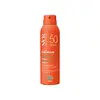What's inside
What's inside
 Key Ingredients
Key Ingredients

 Benefits
Benefits

 Concerns
Concerns

 Ingredients Side-by-side
Ingredients Side-by-side

Dicaprylyl Carbonate
EmollientAlcohol Denat.
AntimicrobialDiethylamino Hydroxybenzoyl Hexyl Benzoate
UV FilterDiisopropyl Adipate
EmollientEthylhexyl Triazone
UV AbsorberBis-Ethylhexyloxyphenol Methoxyphenyl Triazine
Skin ConditioningDiethylhexyl Butamido Triazone
UV AbsorberPolyester-7
Skin ConditioningGlycine Soja Oil
EmollientLepidium Sativum Sprout Extract
Skin ConditioningTocopherol
AntioxidantTocopheryl Acetate
AntioxidantWater
Skin ConditioningCaprylic/Capric Triglyceride
MaskingNeopentyl Glycol Diheptanoate
EmollientParfum
MaskingDicaprylyl Carbonate, Alcohol Denat., Diethylamino Hydroxybenzoyl Hexyl Benzoate, Diisopropyl Adipate, Ethylhexyl Triazone, Bis-Ethylhexyloxyphenol Methoxyphenyl Triazine, Diethylhexyl Butamido Triazone, Polyester-7, Glycine Soja Oil, Lepidium Sativum Sprout Extract, Tocopherol, Tocopheryl Acetate, Water, Caprylic/Capric Triglyceride, Neopentyl Glycol Diheptanoate, Parfum
Water
Skin ConditioningC12-15 Alkyl Benzoate
AntimicrobialEthylhexyl Stearate
EmollientOctocrylene
UV AbsorberButyl Methoxydibenzoylmethane
UV AbsorberGlycerin
HumectantEthylhexyl Salicylate
UV AbsorberPotassium Cetyl Phosphate
EmulsifyingCetearyl Alcohol
EmollientTitanium Dioxide
Cosmetic ColorantPhenylbenzimidazole Sulfonic Acid
UV AbsorberGlyceryl Stearate
EmollientTris-Biphenyl Triazine
UV AbsorberEthylhexyl Triazone
UV AbsorberBis-Ethylhexyloxyphenol Methoxyphenyl Triazine
Skin ConditioningAminomethyl Propanol
BufferingAcrylates/C10-30 Alkyl Acrylate Crosspolymer
Emulsion StabilisingPhenoxyethanol
PreservativeAlumina
AbrasivePiroctone Olamine
PreservativeDecyl Glucoside
CleansingDisodium Phosphate
BufferingSimethicone
EmollientDiethylhexyl Sodium Sulfosuccinate
CleansingXanthan Gum
EmulsifyingButylene Glycol
HumectantCaprylyl Glycol
EmollientPropylene Glycol
HumectantSilver Chloride
PreservativeWater, C12-15 Alkyl Benzoate, Ethylhexyl Stearate, Octocrylene, Butyl Methoxydibenzoylmethane, Glycerin, Ethylhexyl Salicylate, Potassium Cetyl Phosphate, Cetearyl Alcohol, Titanium Dioxide, Phenylbenzimidazole Sulfonic Acid, Glyceryl Stearate, Tris-Biphenyl Triazine, Ethylhexyl Triazone, Bis-Ethylhexyloxyphenol Methoxyphenyl Triazine, Aminomethyl Propanol, Acrylates/C10-30 Alkyl Acrylate Crosspolymer, Phenoxyethanol, Alumina, Piroctone Olamine, Decyl Glucoside, Disodium Phosphate, Simethicone, Diethylhexyl Sodium Sulfosuccinate, Xanthan Gum, Butylene Glycol, Caprylyl Glycol, Propylene Glycol, Silver Chloride
 Reviews
Reviews

Ingredients Explained
These ingredients are found in both products.
Ingredients higher up in an ingredient list are typically present in a larger amount.
You might know this ingredient as Tinosorb S or Bemotrizinol. It is a UV filter that covers both UVA and UVB rays.
This ingredient has two peak UV absorption peaks ( 310 and 340 nm) and is able to absorb both UV-A and UV-B rays. This ingredient works by preventing UV rays from reaching and damaging your skin.
On top of that - it is highly photostable and helps prevent the photodegration of other sunscreen ingredients such as avobenzone.
Tinosorb S is allowed in the EU, Australia, and Asia. It is close to being approved by the FDA and we'll hopefully get this ingredient in the U.S. by late 2025.
Fun fact: Tinosorb S is the most effective UV absorber at maximum concentration (measured by SPF) permitted in the EU.
This ingredient is oil-soluble, so your oil-cleansers will take this right off at night.
Learn more about Bis-Ethylhexyloxyphenol Methoxyphenyl TriazineEthylhexyl Triazone is a modern chemical sunscreen that protects from UV-B radiation.
It is the most effective of existing UV-B filters, as it provides the highest level of photo-stable absorption. It protects from the entire UV-B range (280 to 320nm), with it's highest level of protection at 314nm.
Ethylhexyl Triazone is oil soluble, oderless and colorless, which mean it is able to be incorporated into a variety of different formulations.
It is not currently available within the United States due to slow changing FDA regulations. Outside of the US, it is used in formulations at concentrations up to 5%.
Learn more about Ethylhexyl TriazoneWater. It's the most common cosmetic ingredient of all. You'll usually see it at the top of ingredient lists, meaning that it makes up the largest part of the product.
So why is it so popular? Water most often acts as a solvent - this means that it helps dissolve other ingredients into the formulation.
You'll also recognize water as that liquid we all need to stay alive. If you see this, drink a glass of water. Stay hydrated!
Learn more about Water